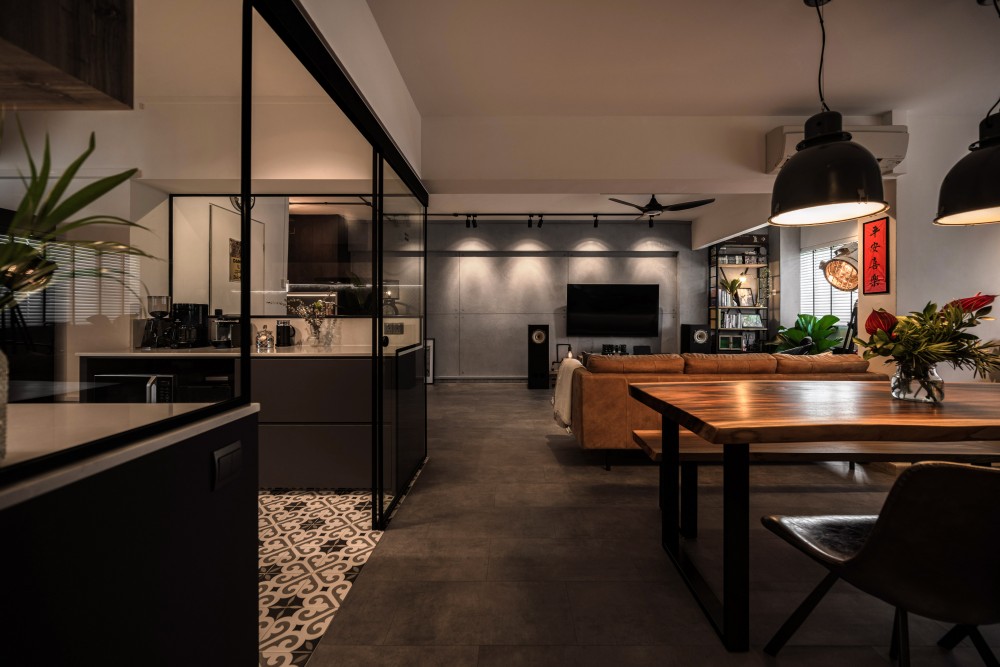Your Guide To Choosing Your Kitchen Hood
A kitchen hood is very much an essential appliance these days.
You’d be hard-pressed to find someone who doesn’t have a kitchen hood – because we all want to maintain a clean and odor-free cooking environment.
With the wide variety of options available, choosing the right kitchen hood can be a daunting task.
This comprehensive guide aims to help you make an informed decision by providing valuable insights into selecting the perfect kitchen hood for your home.
Let’s jump right in!
Step 1: Understand Your Needs
First, start by evaluating your cooking habits and frequency.
Consider the types of food you cook and the level of odors and fumes generated.
If you frequently cook strong-smelling dishes (such as curry) or do heavy frying, it’s advisable to choose a kitchen hood with higher suction power.
This way, you can effectively remove the strong odors and keep your kitchen fresh.
On the flip side, if you cook mostly pasta, salads, or dishes that don’t generate strong odors, you may not require a kitchen hood with high suction power.
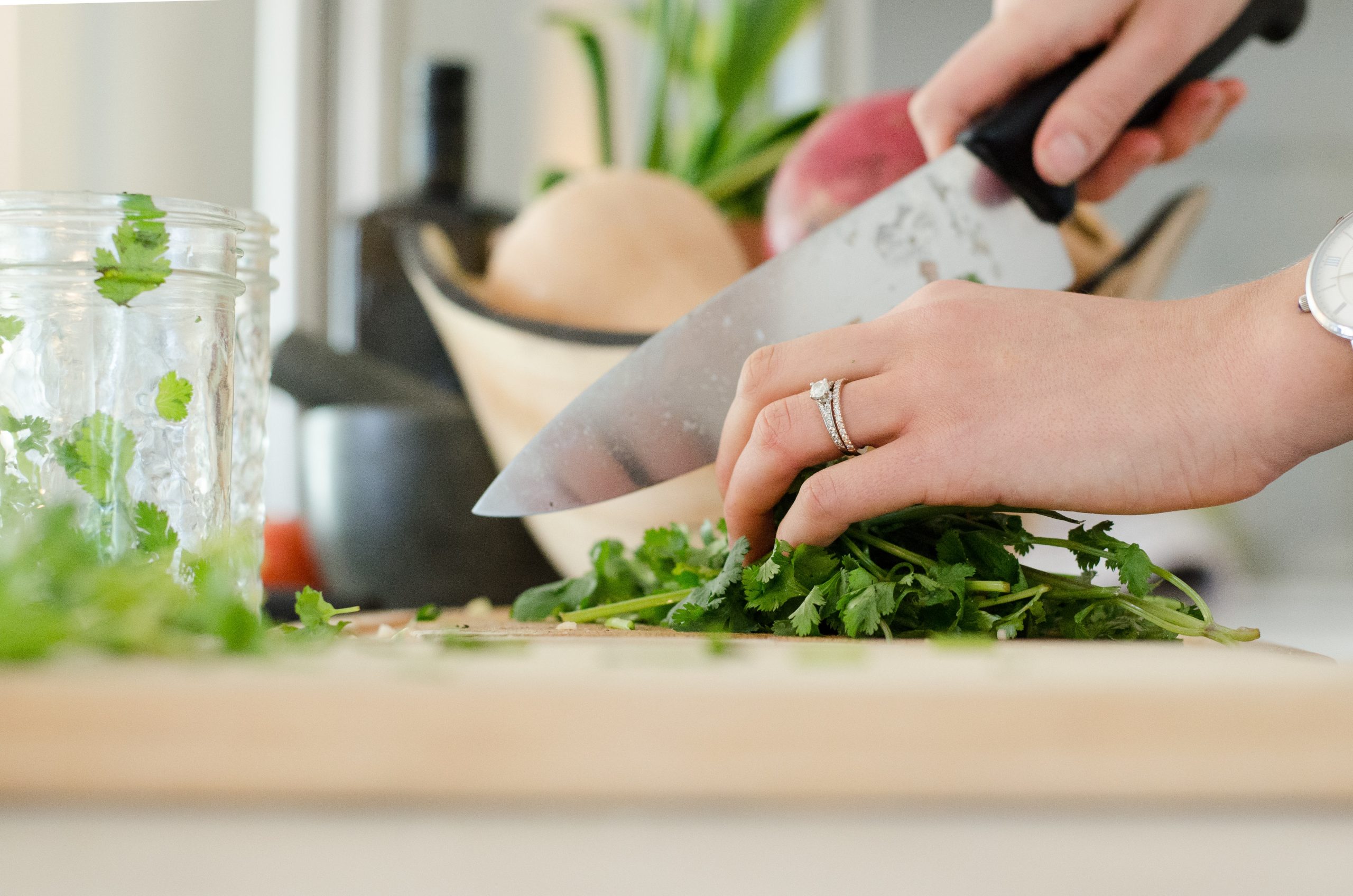

In such cases, a kitchen hood with moderate suction power would suffice to remove any minor cooking odors and maintain a comfortable kitchen environment.
By selecting a kitchen hood that aligns with your specific cooking habits, you can strike a balance between effective odor removal and energy efficiency.
Other than evaluating your cooking habits, do also keep your kitchen size and layout in mind.
The size and layout of your kitchen play a crucial role in determining the type and size of the kitchen hood you should choose.
For smaller kitchens, slimline cooker hoods or under-cabinet hoods are space-saving options.
These hoods are designed to fit neatly beneath overhead cabinets, providing efficient ventilation without compromising on space.
On the other hand, larger kitchens can accommodate island cooker hoods or chimney cooker hoods.
Island cooker hoods are suspended from the ceiling and provide effective ventilation over the island cooking area, while chimney cooker hoods are installed against a wall and offer efficient extraction and ventilation for various kitchen setups.
Step 2: Choose The Type Of Cooker Hood Circulation
There are two primary types of cooker hood circulation: recycling hoods (ductless) and ventilating hoods (ducted).
First, let’s talk about recycling hoods.
Recycling hoods filter and recirculate the air back into the kitchen, while ventilating hoods extract the air and expel it outside.
These hoods are easier to install and suitable for apartments or locations where ducting is not possible.
How do they work? They typically contain charcoal filters to remove odors and grease particles before recirculating the filtered air.
Then you have ventilating hoods, which provide more effective ventilation by removing odors and pollutants from the kitchen entirely.
These hoods require ducting to expel the air outside. They generally involve a more complex installation, but offer superior performance in terms of air extraction.
In terms of which to choose, it’s a pretty standard decision based on the type of property you live in.
If you live in a HDB apartment or condo unit in Singapore, go for the recycling hood – it’s easy to install, and it should be sufficient in filtering and recirculating clean air to your kitchen.
If you live in a landed property, you have the option of getting a ventilating hood.
This will direct smoke and moisture directly out of your house, ensuring that your kitchen is odour-free.
Step 3: What To Consider When Buying A Kitchen Hood
Here are a few factors to keep in mind when buying a kitchen hood:
- Ventilation power
- Filter system
- Energy efficiency
- Noise levels
- Controls and features
Ventilation power
The first thing to keep in mind when buying a kitchen hood is the hood’s ventilation power.
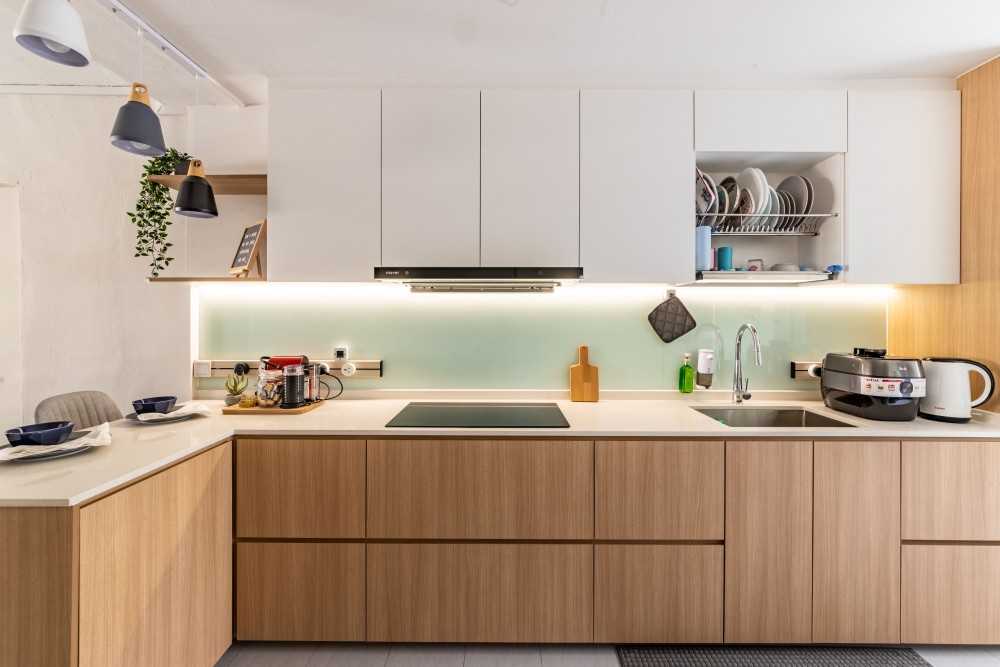

302 Ang Mo Kio ($54,000) by Livspace
This is typically measured in CFM (Cubic Feet per Minute), which tells you the airflow capacity.
In simple terms, CFM refers to the volume of air a hood can move per minute.
Calculating the required CFM depends on the size of your kitchen.
As a general rule of thumb, multiply the kitchen’s length, width, and height to get the total volume in cubic feet.
For optimal ventilation, aim for a hood with a CFM rating that can clear the kitchen’s volume within 4-6 minutes.
We’ve done the math – assuming you stay in a 5-room flat and your kitchen is the typical size for such a flat, you should get a hood with a CFM rating of 200-400 CFM.
It is important to note that while the specifications mentioned on brochures provide valuable information about kitchen hoods, they may not always accurately translate into real-life performance.
To truly assess the suction power of a hood, it is advisable to test it firsthand. One simple test involves visiting a showroom (such as Harvey Norman, where you can compare hoods from multiple brands).
When you’re there, request to turn on the hood to observe its performance. At the same time, place a piece of paper near the hood’s intake area while it is running.
This will allow you to gauge the suction power by observing how firmly the paper is held against the hood.
Interestingly, you might find that some hoods with lower CFM ratings exhibit unexpectedly strong suction, surpassing what their specifications may suggest.
This discrepancy can be attributed to several factors.
The design and efficiency of the hood’s fan motor, the configuration of the filters, and the overall airflow dynamics all contribute to the suction power.
Some hoods may incorporate advanced technologies or innovative design features that enhance their performance, even with lower CFM ratings.
Therefore, relying solely on CFM ratings stated on brochures may not provide a complete picture of a hood’s actual suction capabilities. Personal testing and observation are crucial in evaluating the effectiveness of a hood in capturing cooking fumes, smoke, and odors.
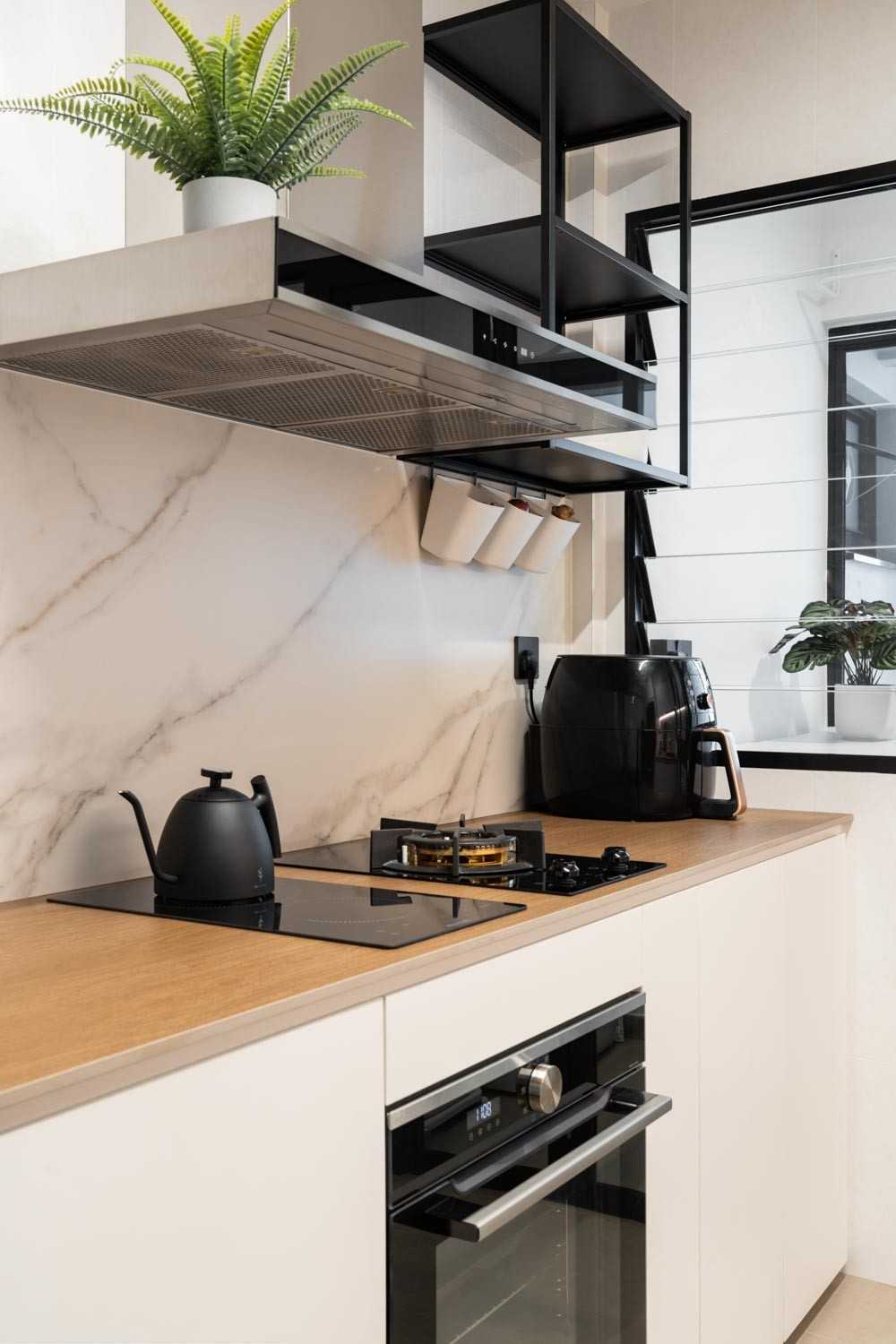

411 Northshore Drive ($50,000) by Dots ‘N’ Tots Interior Pte Ltd
Filter system
Next, also pay attention to the hood’s filter system.
Different types of filters are used in kitchen hoods to capture grease and airborne particles. The most common types include mesh filters, baffle filters, and activated charcoal filters.
- Mesh filters are made of layered aluminum or stainless steel mesh that traps grease particles.
- Baffle filters feature multiple layers of aluminum or stainless steel fins that help redirect airflow, effectively capturing grease and oil.
- Activated charcoal filters, often used in recycling hoods, are designed to absorb odors and remove impurities from the recirculated air.
Now that you understand the differences, let’s discuss what filters might be suitable for you.
Broadly speaking, those with recycling hoods (ie those who live in HDB flats or condos) should go for activated charcoal filters, while those with ventilating hoods (ie those who live in landed properties) can choose between mesh filters and baffle filters.
First, mesh filters are suitable for individuals who regularly cook dishes that produce moderate levels of grease.
However, note that mesh filters may require frequent cleaning to ensure optimal performance. It’s important to follow the manufacturer’s instructions for cleaning and maintenance to prevent clogging and maintain proper airflow.
Then you have baffle filters, which are recommended for individuals who frequently cook dishes that generate high levels of grease and oil.
If you love to cook zi char-style dishes and do a lot of heavy cooking, baffle filters will be a good fit for you.
Note that baffle filters may have a more complex design with multiple layers, which can make cleaning a bit more time-consuming. However, their superior filtration capabilities make them a preferred choice for heavy-duty cooking.
Lastly, activated charcoal filters are suitable for anyone using recycling hoods.
Keep in mind that these filters have a lifespan, and need to be replaced periodically.
Energy efficiency
Opting for an energy-efficient kitchen hood not only reduces utility bills but also minimizes environmental impact.
Look for models with energy-saving features such as LED lighting, which consumes less energy compared to traditional lighting options.
Variable fan speeds are another energy-efficient feature that allows you to adjust the ventilation power based on your cooking needs, reducing unnecessary energy consumption.
Noise levels
Consider the noise levels of the kitchen hood, particularly if you have an open kitchen or if your kitchen is adjacent to your living area.
Excessive noise from the hood can be disruptive and affect your overall living experience.
This consideration is particularly important for households with babies or toddlers. Young children are more sensitive to loud noises, and a noisy kitchen hood may disturb their sleep or cause discomfort.
Here, look for models with noise-reducing features such as insulated motors or sound-absorbing materials.
Controls and features
Kitchen hoods offer various control options and additional features to enhance convenience and functionality.
These days, touch controls are becoming increasingly popular, because they allow for easy and precise operation with a simple touch of the control panel.
Then there are remote controls, which offer the flexibility to adjust the hood settings from a distance.
Some advanced models of hoods even offer smart controls that can be operated through smartphone apps or voice commands.
Other useful features include auto-shutoff, which automatically turns off the hood after a specified time, and heat sensors that adjust the ventilation power based on the cooking temperature.
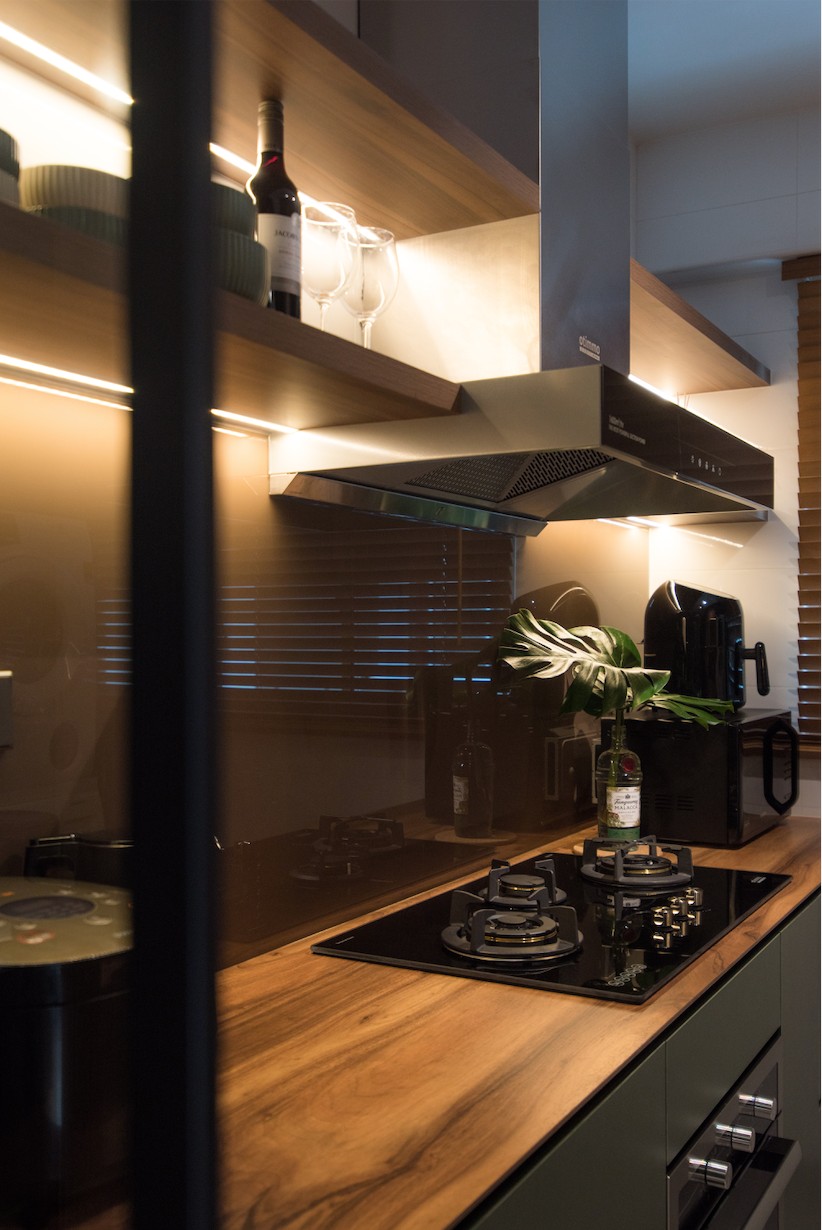

HDB BTO at Northshore Drive ($50,000) by De Style Interior Pte Ltd
Step 4: Decide What Type Of Kitchen Hood You Want
Here are the various types of kitchen hoods that you can choose from:
- Chimney cooker hood
- Inclined cooker hood
- Slimline cooker hood
- Island cooker hood
- Downdraft hood
Chimney cooker hood
Chimney cooker hoods are a popular choice for Singaporean kitchens.
These hoods typically consist of a canopy, a chimney extension, and a fan or motor unit. They look like a chimney – hence the name.
Size-wise, they come in various sizes to suit different kitchen setups and provide efficient extraction and ventilation.
The canopy captures the cooking fumes, and the motor or fan unit extracts and expels the air outside through a duct.
Advantages of a chimney cooker hood: they’re more heavy-duty than other hoods, and they can handle heavy cooking.
Disadvantages of a chimney cooker hood: they’re bulky, and you won’t be able to install any cabinets above them.
Inclined cooker hood
Inclined cooker hoods aren’t super common in Singapore – we don’t see them all that often.
These hoods are installed at an inclined angle (usually positioned above the cooktop).
What’s the point of having an inclined angle? This provides better access to the cooking area, as the inclined position creates more space and visibility while cooking.
The inclined angle also ensures effective extraction of fumes and odors, as the hood is positioned closer to the source of cooking emissions.
While not as prevalent as other hood types, inclined cooker hoods are gaining popularity among homeowners who prioritize functionality and accessibility in their kitchen design.
Advantages of an inclined cooker hood: Ergonomic design and enhanced visibility
Disadvantages of an inclined cooker hood: Installation may be more complex – the inclined position requires careful measurements and adjustments to ensure proper alignment and functionality.
Also, inclined cooker hoods are not as widely available as other types of hoods. Due to their less common nature, the variety of models and brands in the market might be limited.
Slimline cooker hood
Slimline cooker hoods are the most aesthetic of the bunch.
They’re really sleek – you literally just see a thin horizontal piece that cuts across your kitchen cabinetry.
These hoods are designed to fit neatly beneath overhead cabinets, and they’re perfect for small kitchens. (Or for people who have big kitchens, but still prefer a slim hood).
Most people who go for slimline hoods opt for telescopic models.
These can be extended when in use and retracted when not needed, so they’re not jutting out all the time.
Advantages of a slimline cooker hood: Sleek, space-saving design, able to fit below and overhead cabinet.
Disadvantages of a slimline cooker hood: Slimline cooker hoods typically have lower suction power compared to larger hoods, and are not suitable for households who do heavy cooking.
Island cooker hood
For kitchens with an open layout or an island cooktop, island cooker hoods are the perfect choice.
These hoods are suspended from the ceiling above the island, providing effective ventilation over the cooking area.
Island hoods are designed to be visually appealing, acting as a focal point in the kitchen while efficiently removing cooking odors and fumes.
They are available in various styles and sizes to complement different kitchen designs.
Advantages of island cooker hoods: They typically have wider canopies and higher suction power to effectively capture fumes and odors from multiple cooking burners.
Disadvantages of island cooker hoods: Island cooker hoods require sufficient ceiling height and space above the island cooktop to accommodate their installation. If you have low ceilings or limited space, an island cooker hood may not be a practical option for your kitchen.
Similar to inclined cooker hoods, it’s also a complex task to install an island cooker hood. It typically requires careful positioning, secure attachment, and proper ducting to ensure stability and effective ventilation.
Downdraft hood
Downdraft hoods have only become a thing over the last few years, but they’re quickly catching on.
These are typically installed behind or alongside the cooking appliances, such as cooktops.
When not in use, the downdraft hood remains hidden from view, seamlessly integrated into the countertop.
To activate the downdraft hood, you can press a button or use a control panel.
Upon activation, the hood rises vertically from the countertop to the desired height. Some models may have adjustable height settings, allowing you to customize the extraction level based on your cooking needs.
As the downdraft hood rises, it effectively extracts fumes, smoke, and odors produced during cooking. The extraction occurs at the same level as the cooktop, ensuring efficient ventilation.
The fumes and odors are then drawn down into the hood through a vent located at the top, capturing them before they disperse into the kitchen.
Once you have completed your cooking, you can retract the downdraft hood by pressing the button or using the control panel.
The hood will descend back into its hidden position within the countertop, maintaining a clean and unobstructed view of the kitchen when not in use.
Downdraft hoods are particularly suitable for minimalist kitchens or spaces where a traditional overhead hood might obstruct the view or disrupt the kitchen design.
Their ability to remain hidden when not in use provides a seamless and uncluttered aesthetic, making them a popular choice amongst young couples.
Advantages of a downdraft hood: Sleek, unobtrusive, space-saving.
Disadvantages of a downdraft hood: May have slightly lower suction power compared to traditional overhead hoods. The vertical extraction method may not be as efficient in capturing and removing all cooking byproducts, especially for heavy-duty cooking or kitchens with high demands for ventilation.
Downdrafts hood are also more expensive compared to traditional overhead hoods. The specialized design, retractable mechanism, and additional installation requirements contribute to the higher price tag.
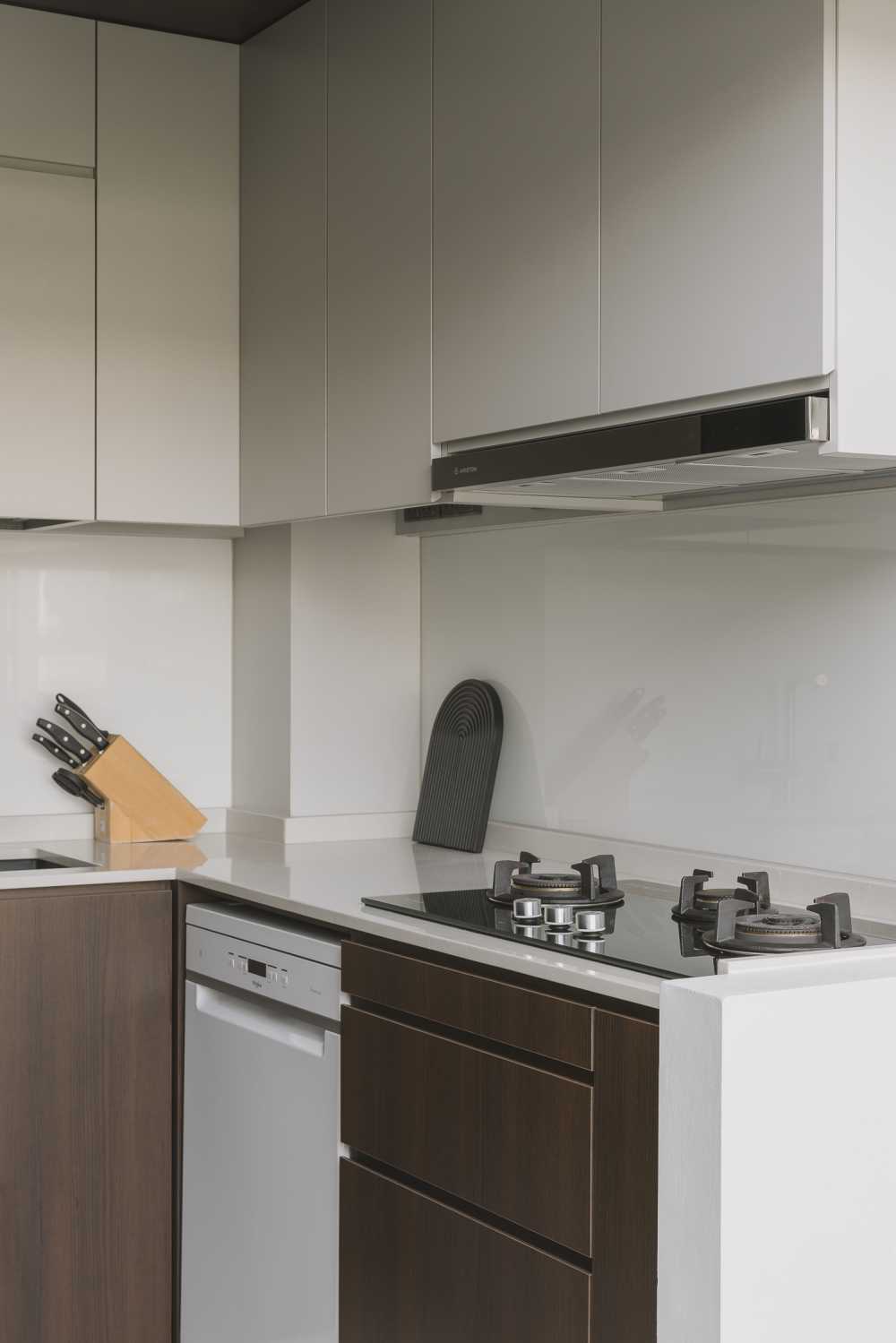

857 Tampines ($200,000) by The Interior Lab Pte Ltd
Step 5: Think About Maintenance
Before you go ahead and purchase your kitchen hood, do some research about the maintenance required.
There are a few things to keep in mind here, including filter cleaning/replacement, grease removal, and cleaning the exterior of the hood.
We briefly talked about filter cleaning previously – essentially, you need to regularly clean or replace your kitchen hood filters to prevent clogging and ensure optimal airflow.
Here, refer to the manufacturer’s instructions for specific cleaning guidelines. Some filters may be dishwasher-safe, while others may require hand-washing with mild detergent and warm water.
Next, grease can accumulate on the interior surfaces of the hood, including the canopy, fan blades, and ductwork.
Regular cleaning is necessary to remove the grease, as it affects hood performance and poses a fire hazard.
To remove the grease, use a degreaser or a mixture of warm water and mild dish soap to wipe down these surfaces. Take care to avoid contact with electrical components and follow safety precautions.
Last but not least, remember to clean the exterior surfaces of the hood as well.
To do this, wipe the exterior surfaces (including the control panel and any visible parts), with a soft cloth or sponge dampened with mild detergent and water.
Avoid using abrasive cleaners or scouring pads that can damage the finish. Dry the surfaces thoroughly to prevent water spots or damage.
A Final Word On Choosing Your Kitchen Hood
There’s no one size fits all when it comes to kitchen hoods – what’s the best choice for your friend might not necessarily be the best for you.
With this in mind, make sure you consider your lifestyle and needs, and do your due diligence before buying a hood.
Want to check out home renovation projects for more inspiration? Browse kitchen designs on Hometrust, or click the button below to get connected with expert designers!
Renovating soon? Let Hometrust recommend the best interior designers.
If you are reading this, you are probably wondering how you can create your dream home.
Here’s the thing, everyone’s needs and requirements for their home renovation is different. A designer that may work for someone else, may not quite work for you.
At Hometrust, we’re here to help match top rated designers, recommended by past homeowners to you through our data-driven and matching algorithm.
Whether you are looking for partial renovation or a full fledge overhaul, we’ll be able to recommend you top designers to match your renovation requirements and lifestyle.
Recommendations and free and you can simply start by helping us understand your needs below!
Get RecommendationsRenovate safe!
The Hometrust Team




